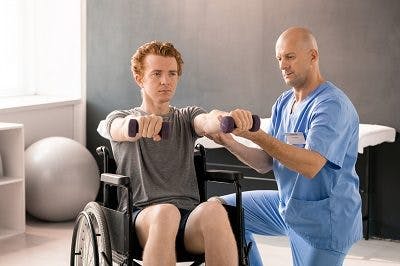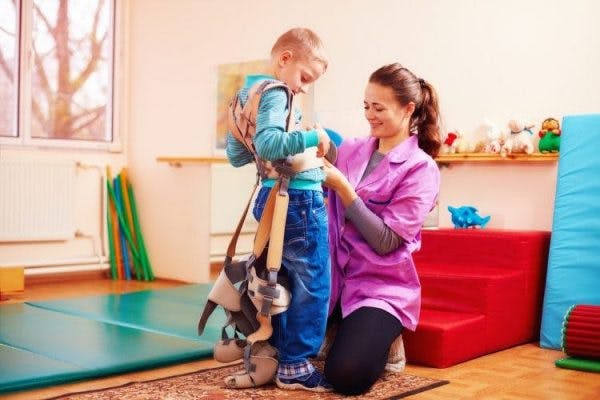The effects of cerebral palsy can change over time and present themselves differently as individuals become adults. Fortunately, the behaviors you consistently practice can significantly influence whether these changes are beneficial or harmful to your mobility and quality of life. With the right management interventions, adults with cerebral palsy can promote functional improvements and maximize their quality of life.
To help you understand how cerebral palsy can change as individuals transition into adulthood, this article will discuss:
- How cerebral palsy changes in adulthood
- How adults with cerebral palsy can improve their mobility
- Management interventions for adults with cerebral palsy
How Cerebral Palsy Changes in Adulthood
Cerebral palsy is a motor disability caused by damage to the developing brain. The brain damage is static, meaning that although it is permanent, it will not worsen over time. However, that does not mean the effects caused by cerebral palsy will not change as you get older. The secondary effects of cerebral palsy are ever-changing and based on how you manage them, these effects can improve or worsen in adulthood.
The bodies of individuals with cerebral palsy generally have to work harder to compensate for motor impairments. As a result, they age at a quicker rate. Consequently, as individuals with cerebral palsy become adults, they are more prone to developing complications related to aging than age-matched adults without CP.
Secondary complications of cerebral palsy that may change in adulthood include:
- Musculoskeletal and joint weakness
- Gastroesophageal reflux
- Pain
- Fatigue
- Bowel and bladder dysfunction
- Spasticity
Fortunately, it is possible to promote beneficial changes and improve functions affected by cerebral palsy. The following section will discuss how the brain can be influenced to make positive changes in one’s functional abilities.
How Adults with Cerebral Palsy Can Improve Their Mobility
The brain has an inherent ability to reorganize its neural circuitry and make adaptive changes known as neuroplasticity. It never runs out of neuroplasticity, so even as an adult, functions affected by cerebral palsy can be improved.
A leading clinical neurologist, Dr. Karen Pape, explains in her book, The Boy Who Could Run But Could Not Walk, that abnormal movement patterns in individuals with cerebral palsy are generally the result of developing and solidifying bad habits. For example, if a child has spasticity in their legs, it may pull their legs into abnormal positions as they learn how to walk. Because they continuously practice walking with compromised form, they develop a habit of walking with an abnormal gait.
Dr. Pape suggests that with the right management interventions, the brain can utilize neuroplasticity to develop new habits that can replace the bad ones. The most effective way to do this is to present the individual with a new challenge. Each function you perform sets off a different set of neural pathways in the brain. By approaching the function you wish to improve in a new way and consistently practicing it, you’ll activate and strengthen a new set of neural pathways that are not affected by brain damage.
The brain adapts in response to demand. Therefore, repeatedly practicing the functions you wish to improve will help reinforce demand in the brain and promote adaptive changes. The following section will discuss management interventions that individuals with CP can utilize to optimize their functional mobility as adults.
Management Interventions for Adults with Cerebral Palsy
Every case of cerebral palsy is unique and everyone will experience different secondary complications at varying severities. Therefore, an individualized approach to treatment that targets each individual’s specific secondary complications is ideal. Personalized management of complications will support optimal mobility and functional independence.
It’s essential for individuals with cerebral palsy to understand that their motor impairments can change over time. As a result, the techniques you used to manage your motor impairments at one point in your life may no longer be as effective. Regular checkups will ensure that your current motor impairments are appropriately addressed and help identify new complications as early as possible.
Now that you understand how cerebral palsy can progress in adulthood, let’s discuss management interventions that can support better mobility and reduce the progression of secondary complications.
Physical Therapy

Most individuals with cerebral palsy participate in physical therapy as children but stop going as they become older. As previously mentioned, the effects of cerebral palsy can change over time. Therefore, it is essential to see your physical therapist regularly to address your evolving motor impairments with a personalized exercise regimen. This will help ensure that you’re practicing the most effective exercises for your specific motor impairments and utilizing neuroplasticity to strengthen appropriate movement patterns.
Learn more about physical therapy for cerebral palsy »
Occupational Therapy
Adults with cerebral palsy may benefit from periodically working with an occupational therapist. They can provide you with helpful tips for maintaining your functional independence as you get older.
This may involve learning how to use adaptive tools, which can help individuals with cerebral palsy perform tasks they otherwise may not be able to perform. Occupational therapists can also help individuals optimize their participation in the workplace through education on work simplification techniques, discussing helpful modifications, and promoting proper ergonomics.
Learn more about occupational therapy for cerebral palsy »
Psychotherapy
While management interventions for adults with cerebral palsy primarily tend to focus on physical health, it is essential to also acknowledge how motor impairments can affect an individual’s mental health.
For example, motor impairments can limit one’s independence and participation in social activities. As a result, individuals with cerebral palsy have an increased risk of developing depression or anxiety. Working with a psychotherapist can help address negative emotions and behaviors and teach individuals effective ways to cope.
Learn more about the effects of cerebral palsy on mental health »
Speech Therapy
Some individuals with cerebral palsy may have difficulties controlling their facial muscles. If spasticity in these muscles worsens, they may struggle with feeding and communication. Communication difficulties can make it difficult for individuals to express when they are in pain or need help.
Working with a speech-language pathologist can help individuals strengthen their oral motor muscles or learn more effective ways to communicate their needs. This may involve speech therapy exercises and learning how to use augmentative and alternative communication.
Learn more about speech therapy for cerebral palsy »
Orthoses
Orthoses are wearable devices that support musculoskeletal alignment. This can help prevent spastic muscles from further tightening, gently stretch tight muscles, and provide flaccid muscles with extra structural support. These are generally designed for short-term use and may be used for a short time each day, overnight, or as needed for certain activities.
Learn more about orthoses for cerebral palsy management »
Medications
Medications can help individuals with cerebral palsy manage secondary complications such as pain, sleep difficulties, and muscle tightness.
Most individuals with cerebral palsy experience spasticity and may use muscles relaxants like baclofen or nerve blockers like Botox to reduce involuntary muscle contractions. These medications provide temporary spasticity relief. To promote more long-term relief, individuals with CP should take advantage of their reduced spasticity while under the effects of these medications and practice their therapy exercises to promote adaptive changes in the brain.
Regular Body Inspections
Because individuals with severe cerebral palsy have restricted movement and generally tend to be less physically active, it is essential to perform daily body inspections to identify early signs of pressure ulcers. Signs include redness and skin breakdown due to prolonged pressure in one area. .
The development of pressure ulcers is often painful and can lead to even further mobility restrictions. Early identification and treatment can promote healing and reduce further complications, such as infection.
Surgery
In cases of severe spasticity that do not respond to other management interventions, surgery may be recommended. This may involve selectively severing nerve roots to decrease the hyperexcitability of muscle contractions or manually lengthening tightened muscles.
Cerebral Palsy in Adults: Key Points
The brain damage that causes cerebral palsy will not progress over time, but secondary effects such as spasticity, pain, and fatigue can. Therefore, it is essential for adults with cerebral palsy to continue to actively participate in and utilize management interventions for their motor impairments.
We hope this article helps you understand how cerebral palsy can affect individuals as adults and how to effectively manage motor impairments to improve your quality of life.











